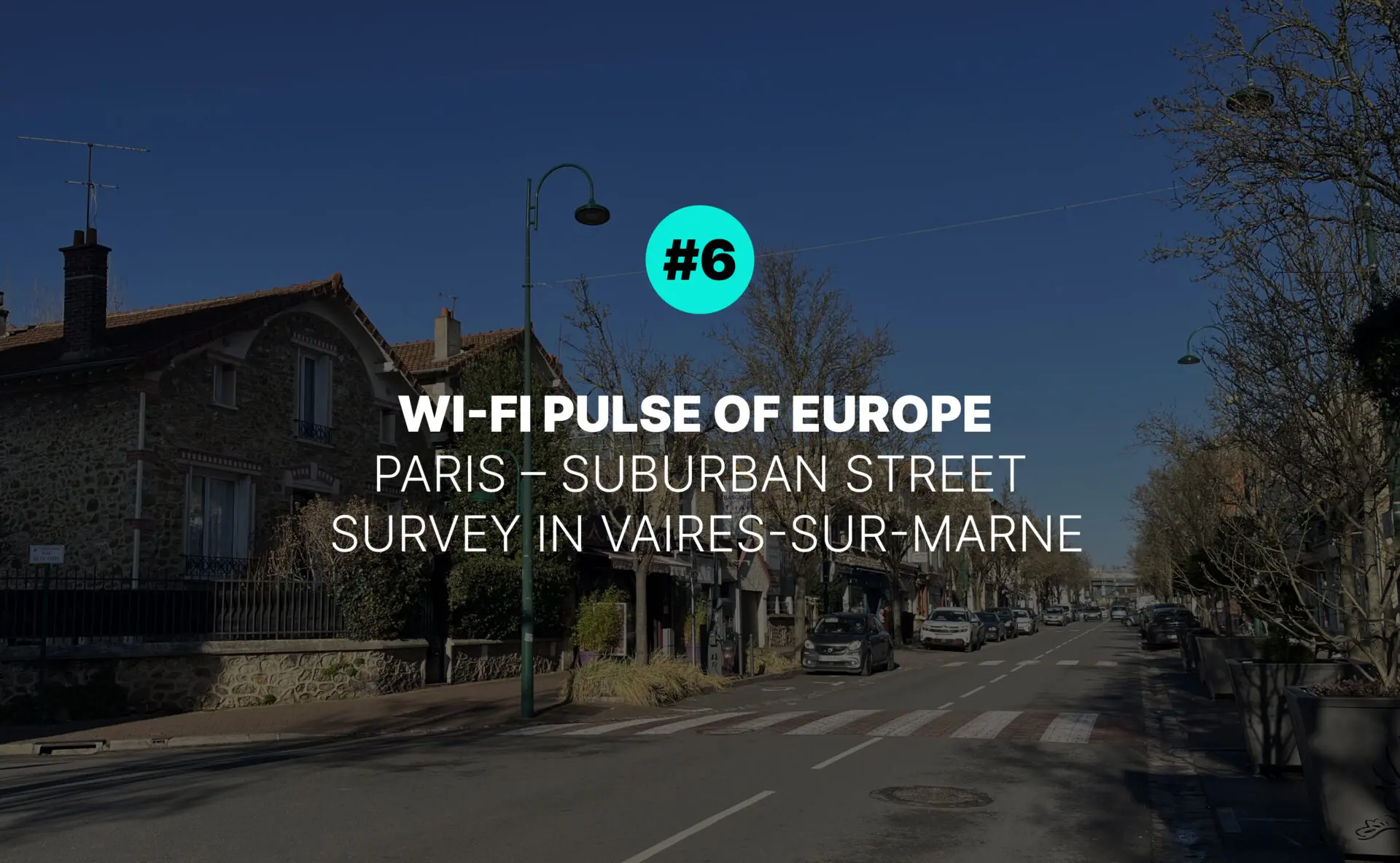The survey described in this article took place on Saturday, February 1, 2025, in Vaires-sur-Marne, a residential suburb just east of Paris. I arrived in the area after two days of work in nearby warehouses, where I conducted Post-Deployment Wireless Surveys for clients on January 30 and 31. These jobs typically involve checking every aspect of a newly installed network: confirming that all access points are properly placed and configured, measuring signal quality across the entire site, and documenting performance with coverage maps and photos. The aim is to make sure that the network matches the design specifications and provides the coverage and capacity required by the client.
On Saturday, I had one more task before heading home: a street-level Wi-Fi survey through the neighborhoods around Vaires-sur-Marne. Unlike indoor warehouse environments, outdoor surveys often allow for accurate GPS-based measurements. In theory, this makes it easy to map each measured data point to its precise location. In practice, a bug in the survey software meant that GPS coordinates could not be recorded automatically that day, so I had to assign measurement points manually on the map. This was slow and tedious, and I flagged the problem to the software vendor afterwards. The issue was fixed in the next release, but at the time it definitely made the job harder than it needed to be.
As a final inconvenience, I couldn’t find a luggage locker at the train station, so I had to drag my suitcase with me during the entire survey. Between the software glitch and the baggage problem, it wasn’t the most convenient day for fieldwork. Still, I got the job done. At least it was clear skies and sunshine, so I managed to finish the survey in the late morning and early afternoon, just in time to catch my evening flight home.
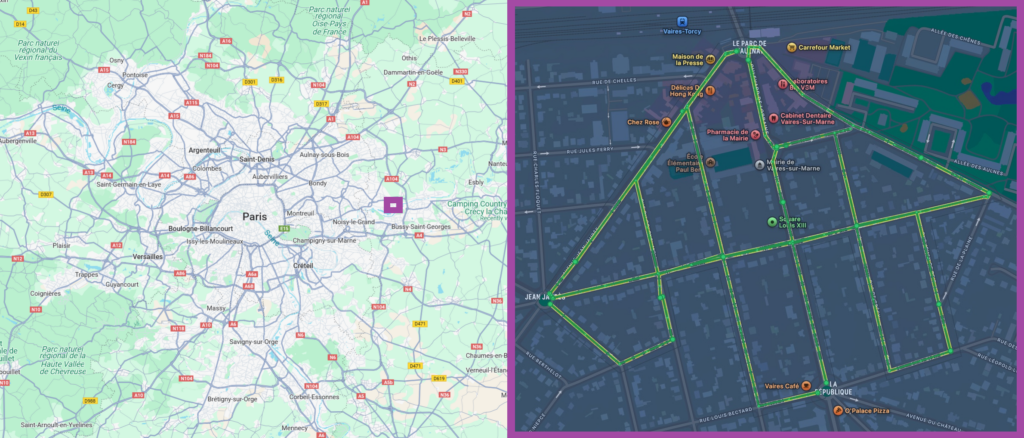
What follows is a detailed look at the wireless landscape of Vaires-sur-Marne, based on several hours of street-level data collection covering approximately 230,000 square meters.
Total Broadcasts Captured
As in previous articles, we distinguish between physical broadcasting devices and the SSIDs (hidden or visible network names) they transmit. A single device can operate on multiple frequency bands and may broadcast several network names on each, often resulting in more SSIDs than underlying hardware. Throughout this report, we shift between SSID-level and device-level observations to provide a full view of the local wireless landscape.
A total of 1,541 physical devices were identified in the area. Most devices were active on either the 2.4 GHz or the 5 GHz band, with 458 devices using only 2.4 GHz and 479 using only 5 GHz. Dual-band operation was also common: 604 devices broadcast on both 2.4 and 5 GHz. Not a single signal was detected on 6 GHz.
The chart below shows the distribution of devices by frequency band.
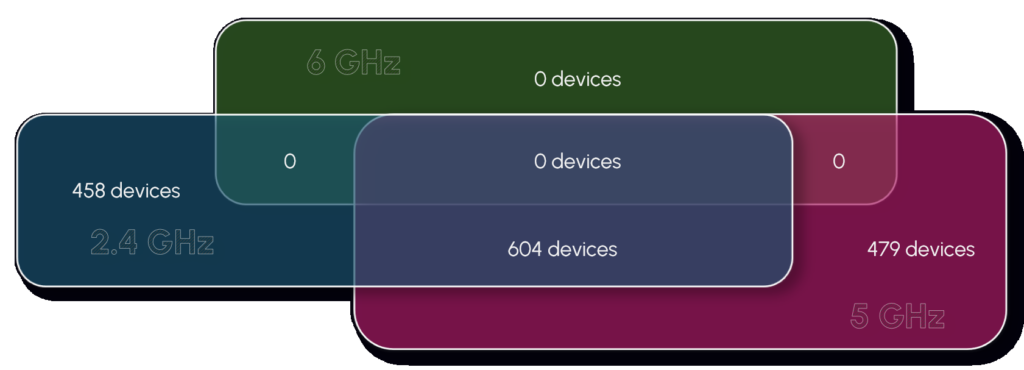
In most cases, a single device broadcasts several SSIDs per band, which leads to a higher overall SSID count than the number of physical devices. We captured a total of 2,661 unique SSIDs across all frequency bands. Out of all detected broadcasts, 2,257 were visible, named networks. The remaining 404 were hidden SSIDs, just over 15 percent of the total. Hiding network names is a common practice in some environments for privacy or perceived security reasons. However, this is the lowest proportion seen so far in this series, matched only by Vigo. For comparison: Helsinki and Porto both had 21 percent, Liverpool 26 percent, and Edinburgh 30 percent hidden networks. This suggests that hiding SSIDs is less common in Vaires-sur-Marne than in most other European cities we have surveyed.
Wi-Fi Technology Versions
he SSIDs detected in Vaires-sur-Marne represent a broad mix of Wi-Fi technology generations, reflecting both legacy equipment and more recent deployments. Most networks use Wi-Fi 4 (802.11n), which accounts for 39 percent of all SSIDs. Wi-Fi 5 (802.11ac) makes up 30 percent, and Wi-Fi 6 (802.11ax) represents 26 percent of the total. Only 2 percent of SSIDs use Wi-Fi 3 or earlier standards, and there were no networks operating with Wi-Fi 6E. A small but noticeable share, nearly 3 percent, were already broadcasting with Wi-Fi 7, suggesting some early adoption of the newest standard in the area.
This distribution is typical for a Western European suburb, where residential infrastructure is often replaced in cycles and a wide variety of devices remain in use. The complete absence of Wi-Fi 6E, combined with the early appearance of Wi-Fi 7, highlights how new technology adoption does not always follow a simple, linear path.
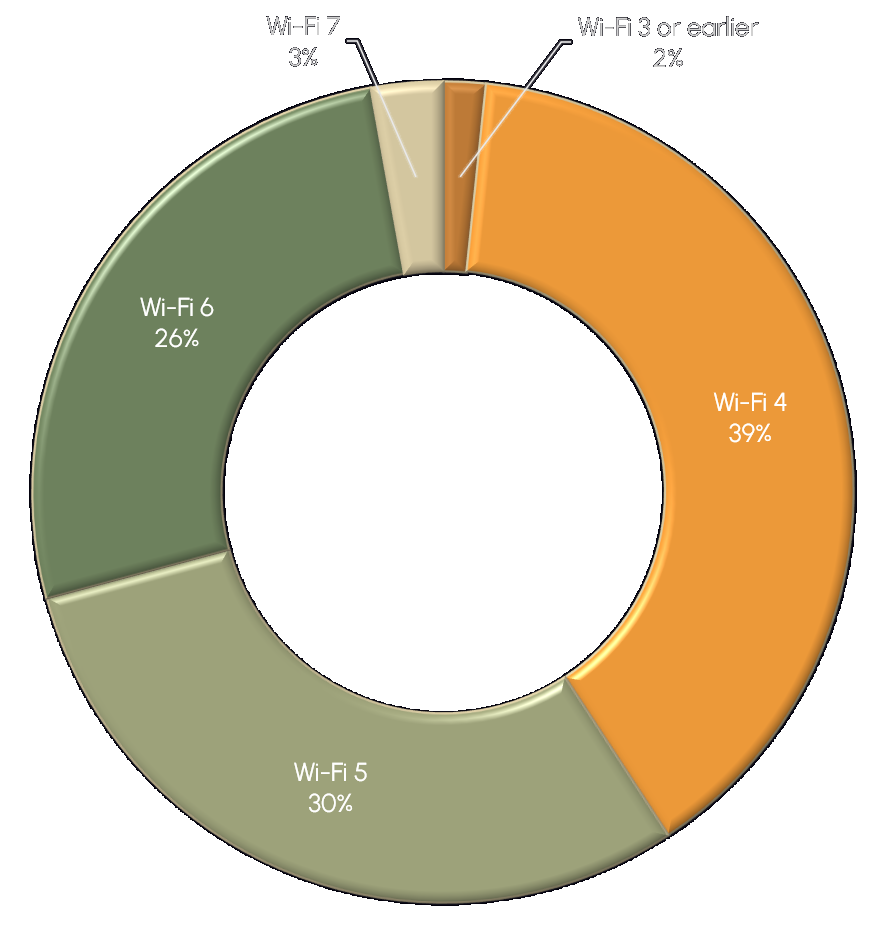
Channel Saturation
Most devices on the 2.4 GHz band either follow industry best practice or do not. In Vaires-sur-Marne, 85 percent of physical devices broadcast exclusively on channels 1, 6, or 11 with a 20 MHz channel width, an unusually high rate that matches only what we saw in Edinburgh. In every other surveyed city, the share of best-practice configurations was noticeably lower. The remaining 15 percent use other settings, meaning they either operate on 40 MHz channel width, use nonstandard channels outside 1, 6, and 11, or do both. These choices may contribute to interference and suboptimal network performance.
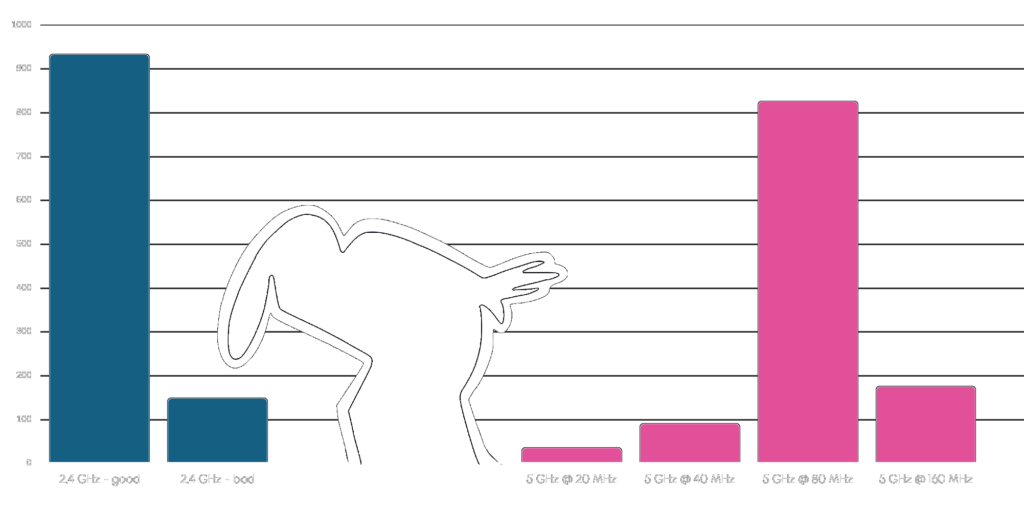
On the 5 GHz band, wide channels are clearly dominant. Three out of four devices operate at 80 MHz channel width, which means 75 percent of all 5 GHz devices in this environment favor the widest commonly available option. Another 15 percent use the maximum 160 MHz width, a figure that stands out even compared to other residential locations we have measured. By contrast, only 7 percent of devices use 40 MHz, and just 2 percent stick with 20 MHz. These numbers highlight the strong influence of default configurations that prioritize throughput and convenience over careful channel planning or local interference management.
The complete absence of 6 GHz activity in this survey likely comes down to a few key factors. First, real-world adoption of 6 GHz Wi-Fi remains low in France. Even though Wi-Fi 6E and 7 routers and access points are now available, most users and organizations have not yet replaced their phones and laptops with models that support the new band. Second, on many broadcasting devices, the 6 GHz band is either disabled by default or requires special configuration to activate, so even capable hardware often runs only on the traditional 2.4 and 5 GHz bands. Third, 6 GHz has the weakest propagation of all the Wi-Fi bands, so its signals are much more easily blocked by walls and distance than those on 2.4 or 5 GHz. If any 6 GHz networks were present, they were most likely operating deep inside buildings or far from the street, where their signals could not reach our survey route.
As for the channel distribution, the 5 GHz spectrum in Vaires-sur-Marne shows a strong preference for a handful of channels, with devices clustering most heavily on channels 36, 52, and 100. Channel 100 alone accounts for 228 devices, while channel 36 hosts 212, and channel 52 comes in third with 114. Other channels see far less activity, with a gradual drop-off across the mid and upper ranges of the band. Channels above 120 are sparsely used, and some, such as channels 140 and 165, are completely unoccupied. This distribution closely mirrors what we found in Vigo, and Porto also shows a similar pattern. By contrast, a different trend is visible in the northern cities: Liverpool and Edinburgh appear almost copy-pasted in their channel use, and Helsinki follows a similar distribution to those as well.
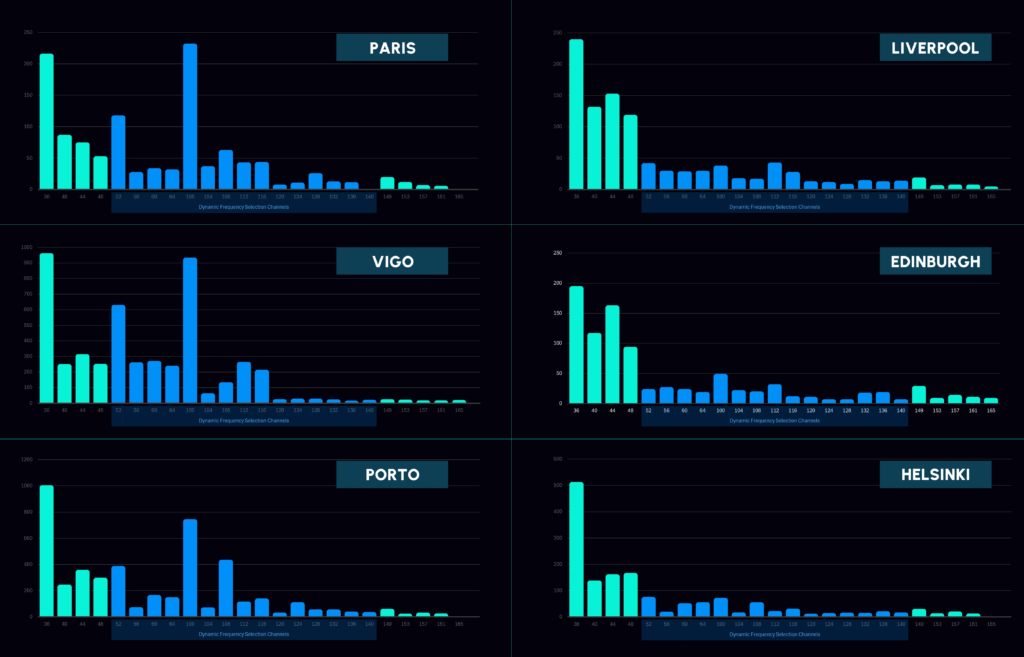
SSID Naming Patterns
The top of the SSID list is dominated by FreeWifi_secure, which is a nationwide roaming network provided by Free for its broadband customers. This type of SSID allows Free subscribers to connect to Wi-Fi wherever another Freebox is broadcasting, and its presence in such high numbers is a common feature of French residential neighborhoods.
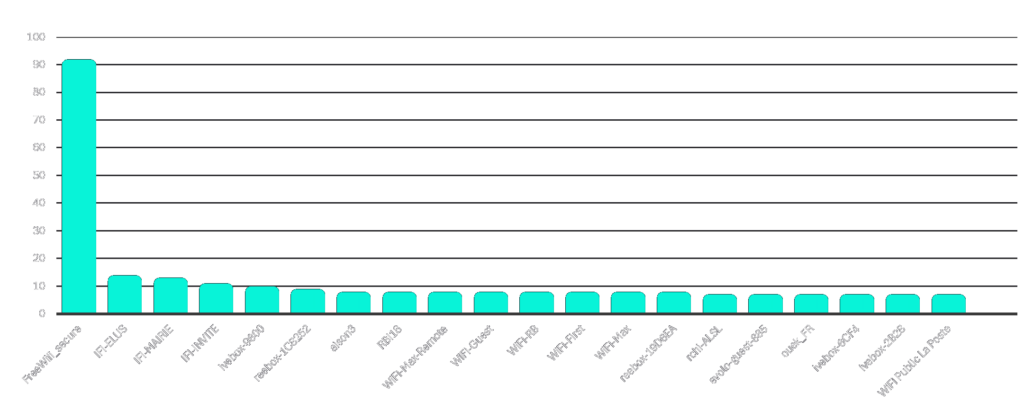
Just below FreeWifi_secure are IFI-ELUS, IFI-MAIRIE, and IFI-INVITE. All of these belong to the local town hall: “ELUS” is likely reserved for elected officials, “MAIRIE” for staff or internal use, and “INVITE” for guest access. The rest of the top names are mostly generic device IDs, default router names, or apartment-specific labels. Examples like Livebox-9800, reebox-1C8252, and RBI18 rarely provide clues about the owner or the intended users.
The influence of major ISPs is clearly visible in the local wireless landscape. Orange-related SSIDs (Livebox) account for 491 networks, followed by SFR with 399, Free (Freebox) with 379, and Bouygues Telecom (Bbox) with 287. These totals show how dominant provider-branded devices are in residential deployments.
As for creative, funny, or surprising Wi-Fi names… you’ll have to look elsewhere. If there’s a prize for the most boring SSID collection in Europe, Vaires-sur-Marne would be a serious contender. Local residents seem committed to making sure their Wi-Fi names are as unremarkable as possible, a true triumph of function over flair.
Who’s Powering Vaires-sur-Marne’s Wi-Fi
The wireless landscape of Vaires-sur-Marne is driven almost entirely by consumer-grade infrastructure, with a few professional deployments scattered throughout the area. The most common manufacturers are Freebox SAS and Sagemcom, which together account for a large share of all detected devices. These are joined by SFR, Ingram Micro, Cisco Meraki, Arcadyan, TP-Link, Sercomm, HP, Anov France, and NetGear. Most of these brands are closely tied to ISP-issued hardware or mass-market retail routers, supplied as part of broadband packages and rarely customized beyond their factory defaults.
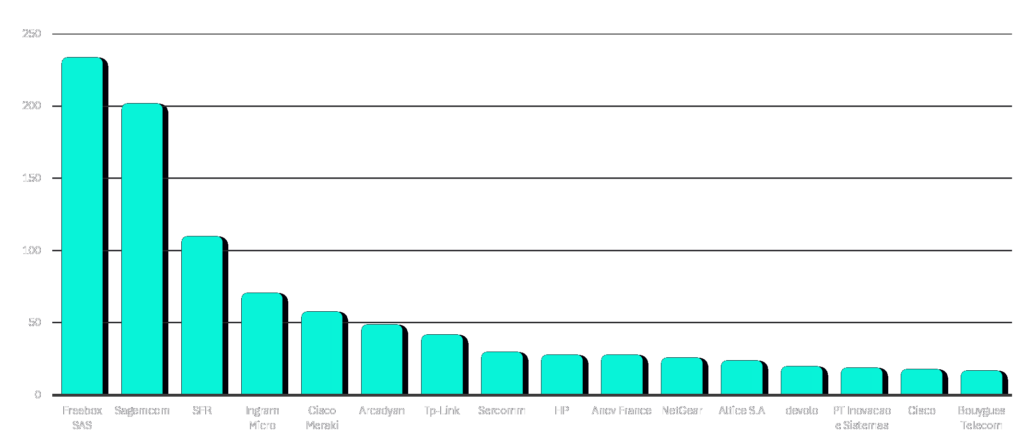
Enterprise-grade vendors, such as Cisco, Meraki, and HP, are present but much less dominant. These devices are typically found in businesses, public buildings, or institutional settings. Their numbers, however, are far outweighed by the tens and hundreds of access points from major consumer brands.
The appearance of specialized manufacturers like Ingram Micro and Anov France reflects the diversity of device sourcing in the area, though these brands are often used as OEM suppliers for ISPs and white-label hardware rather than for direct enterprise deployments.
In short, Vaires-sur-Marne’s Wi-Fi is built on a foundation of standard, provider-supplied devices, reinforced by a handful of business-grade installations, resulting in a landscape that is technically solid, but rarely innovative or customized.
Closing Thoughts
The wireless environment in Vaires-sur-Marne is a textbook example of suburban Wi-Fi in France. Nearly every signal comes from a provider-issued device, most broadcasting default SSIDs and standard settings. Enterprise deployments are rare, creative network names are even rarer, and the presence of the latest technologies, such as 6 GHz Wi-Fi, is effectively nonexistent. If anything stands out, it is the overwhelming dominance of default configurations and the near-uniformity of the networks themselves.
From a technical perspective, the results are predictable but reassuring: most residents have access to stable, modern Wi-Fi, and misconfigurations are less frequent than in many other European cities. Still, the lack of innovation and the almost total absence of customized setups speak volumes about the priorities of both end-users and ISPs: connectivity first, creativity a distant second.
If you’re looking for surprises, hidden gems, or even a little humor in the airwaves, Vaires-sur-Marne might leave you wanting. But if you want a clear picture of how everyday people in suburban France connect to the world: this is it.
Believe it or not, we really enjoy doing these surveys, so we’re taking requests. If there’s a place you think we should scan next, let us know, and we might just walk through with our spectrum analyzer.
Follow us on LinkedIn or sign up for our newsletter to get the next one straight to your inbox. And if you’d like to see what’s going on inside your network, we’re just a message away.

